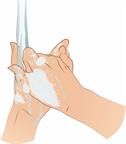Getting a Midline Catheter: What to Expect
A midline catheter is a small, thin tube that is inserted into a vein in the upper arm or at the bend in the elbow. Its tip ends at or near the armpit area. A midline catheter is a type of IV access.
A midline catheter may be used to:- Give IV fluids.
- Give IV medicines.
- Draw blood at the time that the catheter is put in.
- Give blood or blood products.
- Inject contrast dye for a CT scan or MRI.
- Provide IV access for treatment that lasts 1–4 weeks.
Tell a health care provider about:
-
Any allergies you have. This includes allergies to anesthesia or dyes.
-
All medicines you take. These include vitamins, herbs, eye drops, and creams.
-
Any bleeding problems you have.
-
Any surgeries you've had, including if you have had lymph nodes taken out of your armpit or if you have a arteriovenous fistula for dialysis.
-
Any medical problems you have.
-
Whether you're pregnant or may be pregnant.
-
Whether you've used IV drugs.
What are the risks?
Your health care provider will talk with you about risks. These may include:- Pain, bruising, or bleeding.
- Infection.
- The IV leaking or moving out of place.
- Damage to blood vessels or nerves.
- Allergic reactions to medicines or dyes.
- A blood clot.
- An air bubble in the vein, also called an air embolism.
What happens before the procedure?
-
Eat and drink only as you've been told.
- Ask about changing or stopping:
- Any medicines you take.
- Any vitamins, herbs, or supplements you take.
What happens during the procedure?
-
Your skin at the IV site will be washed with fluid that kills germs This will help prevent infection.
-
A bandage or cord, called a tourniquet, will be tightly wrapped around your upper arm.
-
An ultrasound may be used to identify the correct vein.
-
You may be given a medicine to numb the area. This may be applied to or injected into the skin where the IV catheter will be placed.
-
A needle will be used to enter the vein, and the catheter will be placed into the vein.
-
The needle will be taken out, and the catheter will stay in place.
-
The tourniquet will be taken off.
-
A syringe may be attached to the catheter to make sure that you can draw blood from it.
-
The catheter may be flushed with a liquid called saline or heparin.
-
A clear bandage or tape will be used to hold the catheter in place.
These steps may vary. Ask what you can expect.
What can I expect after the procedure?
-
The catheter may be capped for use later on, or an IV may be attached to give fluids, medicine, or blood.
- Your provider will check the IV site as needed to make sure:
- There is no bleeding, swelling, or pain.
- Fluid is flowing through the catheter properly.
- There are no signs of infection.
Follow these instructions at home:
 Follow instructions from your provider about how to take care of your midline catheter at home.
Follow instructions from your provider about how to take care of your midline catheter at home.- Wash your hands with soap and water for at least 20 seconds before and after caring for or using your midline catheter. If you can't use soap and water, use hand sanitizer.
- Before connecting a syringe or tubing to your midline catheter, scrub the tip of your catheter with a new alcohol wipe for 10–14 seconds. Allow the catheter tip to dry completely. Do this every time before you connect the syringe or tubing to your catheter.
- Do not let the midline catheter bandage get wet. Change the bandage right away if it becomes wet.
- Do not take baths, swim, or use a hot tub until you're told it's OK. Ask if you can shower.
- Do not pull on the midline catheter or tubing. Doing this can move the catheter out of its place in the vein and the IV fluids or medicine you are getting can leak into the surrounding tissue.
- Do not allow blood pressure measurements or needle punctures on the side where the midline catheter is located.
- Ask if it's OK for you to lift.
- Redness, swelling, or pain.
- Fluid or blood.
- Warmth.
- Pus or a bad smell.
Contact a health care provider if:
-
You have signs of infection around your midline catheter.
-
The skin is irritated near where the bandage was applied.
-
The bandage is loose and the midline catheter insertion site is exposed.
-
There is bleeding or drainage at the site where the midline catheter goes into your arm.
Get help right away if:
-
You have chills or a fever.
-
Your midline catheter isn't able to be flushed or it feels blocked.
-
The midline catheter is partially or completely pulled out.
-
Your catheter is broken or leaking.
-
You have chest pain or shortness of breath.
-
Do not wait to see if the symptoms will go away.
-
Do not drive yourself to the hospital.
This information is not intended to replace advice given to you by your health care provider. Make sure you discuss any questions you have with your health care provider.

